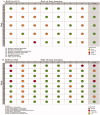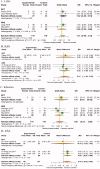Effectiveness of bone substitute materials in opening wedge high tibial osteotomy: a systematic review and meta-analysis
- PMID: 35166617
- PMCID: PMC8856078
- DOI: 10.1080/07853890.2022.2036805
Effectiveness of bone substitute materials in opening wedge high tibial osteotomy: a systematic review and meta-analysis
Abstract
Background: A meta-analysis of eligible studies was performed to evaluate the effectiveness of bone substitute materials (BSMs) in opening wedge high tibial osteotomy (OWHTO) for knee osteoarthritis.
Methods: A systematic review and meta-analysis were conducted according to the Preferred Reporting Items for Systematic Reviews and Meta-Analysis (PRISMA). A comprehensive literature search was performed, and studies comparing BSM with bone graft (BG) and without bone graft (WG) were included. The Cochrane risk of bias tool (version 1.0) and Risk of Bias in Non-randomized Studies of Interventions (ROBINS-I) tool were used to assess the risk of bias for randomized controlled trials (RCTs) and non-randomized studies (NRSs), respectively. The outcomes measured were the osteotomy gap size, the occurrence rates of non-union and lateral hinge fractures, knee functional score, infection and the Visual Analogue Scale (VAS). The quality of evidences was evaluated by Grades of Recommendation, Assessment, Development and Evaluation (GRADE) Working Group system.
Results: Five RCTs and eight NRS including 769 participants were included in our meta-analysis. The BSM group had a larger osteotomy gap size than the control group (MD: 0.41 mm, 95% confidence interval (CI): [0.06, 0.76], p=.02, I2=0%), with a significant difference. No significant difference was found between BSM and control group in main analysis in terms of bone non-union, but with a higher non-union rate when BSM combined with long locking plate was used. No significant differences were found in other outcome measures except for VAS from NRS subgroup. The quality of evidence for outcomes was low.
Conclusions: BSM combined with locking plate techniques offers a safe and efficient alternative option in OWHTO for osteotomy gap larger than 10 mm, but be aware of the possibility of bone non-union. Given the inherent heterogeneity and low quality of the included studies, future well-designed RCTs are essential to verify the findings.KEY MESSAGEThe treatment of the osteotomy gap is still controversial.BSM combined with a locking plate offers a safe and efficient alternative option for OWHTO with an over 10 mm of osteotomy gap over 10 mm.Due to the inherent heterogeneity and low quality of the included studies, the results should be cautiously interpreted in clinical practice.
Keywords: Knee osteoarthritis; bone substitute material; graft; opening wedge high tibial osteotomy.
Conflict of interest statement
The authors have no conflicts of interest to declare.
Figures





Similar articles
-
[Management principle and clinical suggestions of osteotomy gap of opening wedge high tibial osteotomy].Zhongguo Xiu Fu Chong Jian Wai Ke Za Zhi. 2020 Jul 15;34(7):919-926. doi: 10.7507/1002-1892.201909110. Zhongguo Xiu Fu Chong Jian Wai Ke Za Zhi. 2020. PMID: 32666739 Free PMC article. Review. Chinese.
-
Opening-wedge high tibial osteotomy without bone grafting in severe varus osteoarthritic knee. Rate and risk factors of non-union in 41 cases.Orthop Traumatol Surg Res. 2018 Jun;104(4):473-476. doi: 10.1016/j.otsr.2018.01.014. Epub 2018 Mar 16. Orthop Traumatol Surg Res. 2018. PMID: 29555559
-
Plate-related results of opening wedge high tibial osteotomy with a carbon fiber reinforced poly-ether-ether-ketone (CF-PEEK) plate fixation: a retrospective case series of 346 knees.J Orthop Surg Res. 2019 Dec 27;14(1):466. doi: 10.1186/s13018-019-1514-1. J Orthop Surg Res. 2019. PMID: 31881906 Free PMC article.
-
Radiographic and computed tomographic evaluation of bone union after medial opening wedge high tibial osteotomy with filling gap.Knee. 2017 Oct;24(5):1108-1117. doi: 10.1016/j.knee.2017.06.002. Epub 2017 Aug 7. Knee. 2017. PMID: 28797873
-
Is opening-wedge high tibial osteotomy superior to closing-wedge high tibial osteotomy in treatment of unicompartmental osteoarthritis? A meta-analysis of randomized controlled trials.Int J Surg. 2018 Dec;60:153-163. doi: 10.1016/j.ijsu.2018.10.045. Epub 2018 Nov 13. Int J Surg. 2018. PMID: 30445197 Review.
Cited by
-
Research Progress of Combining High Tibial Osteotomy with Platelet-rich Plasma for Osteoarthritis Therapy.Int J Med Sci. 2025 Jul 10;22(13):3250-3259. doi: 10.7150/ijms.114227. eCollection 2025. Int J Med Sci. 2025. PMID: 40765553 Free PMC article. Review.
-
Postoperative management following osteotomies around the knee: a narrative review.EFORT Open Rev. 2024 Jul 1;9(7):658-667. doi: 10.1530/EOR-23-0153. EFORT Open Rev. 2024. PMID: 38949151 Free PMC article. Review.
-
Guidelines for the diagnosis and treatment of knee osteoarthritis with integrative medicine based on traditional Chinese medicine.Front Med (Lausanne). 2023 Oct 17;10:1260943. doi: 10.3389/fmed.2023.1260943. eCollection 2023. Front Med (Lausanne). 2023. PMID: 37915321 Free PMC article. Review.
-
[Research progress in biomechanics of different fixation methods for medial opening-wedge high tibial osteotomy].Zhongguo Xiu Fu Chong Jian Wai Ke Za Zhi. 2025 Jun 15;39(6):769-776. doi: 10.7507/1002-1892.202504010. Zhongguo Xiu Fu Chong Jian Wai Ke Za Zhi. 2025. PMID: 40545468 Free PMC article. Review. Chinese.
-
The results of allogenic cancellous bone graft in medial opening wedge high tibial osteotomy.Eur J Orthop Surg Traumatol. 2023 Apr;33(3):623-627. doi: 10.1007/s00590-022-03335-7. Epub 2022 Jul 22. Eur J Orthop Surg Traumatol. 2023. PMID: 35867166
References
-
- Buckwalter JA, Martin JA.. Osteoarthritis. Adv Drug Deliv Rev. 2006;58(2):150–167. - PubMed
-
- Zampogna B, Vasta S, Papalia R.. Patient evaluation and indications for osteotomy around the knee. Clin Sports Med. 2019;38(3):305–315. - PubMed
-
- Floerkemeier S, Staubli AE, Schroeter S, et al. . Outcome after high tibial open-wedge osteotomy: a retrospective evaluation of 533 patients. Knee Surg Sports Traumatol Arthrosc. 2013;21(1):170–180. - PubMed
-
- Sen MK, Miclau T.. Autologous iliac crest bone graft: should it still be the gold standard for treating nonunions? Injury. 2007;38(Suppl. 1):S75–S80. - PubMed
Publication types
MeSH terms
Substances
LinkOut - more resources
Full Text Sources
Other Literature Sources
Miscellaneous
